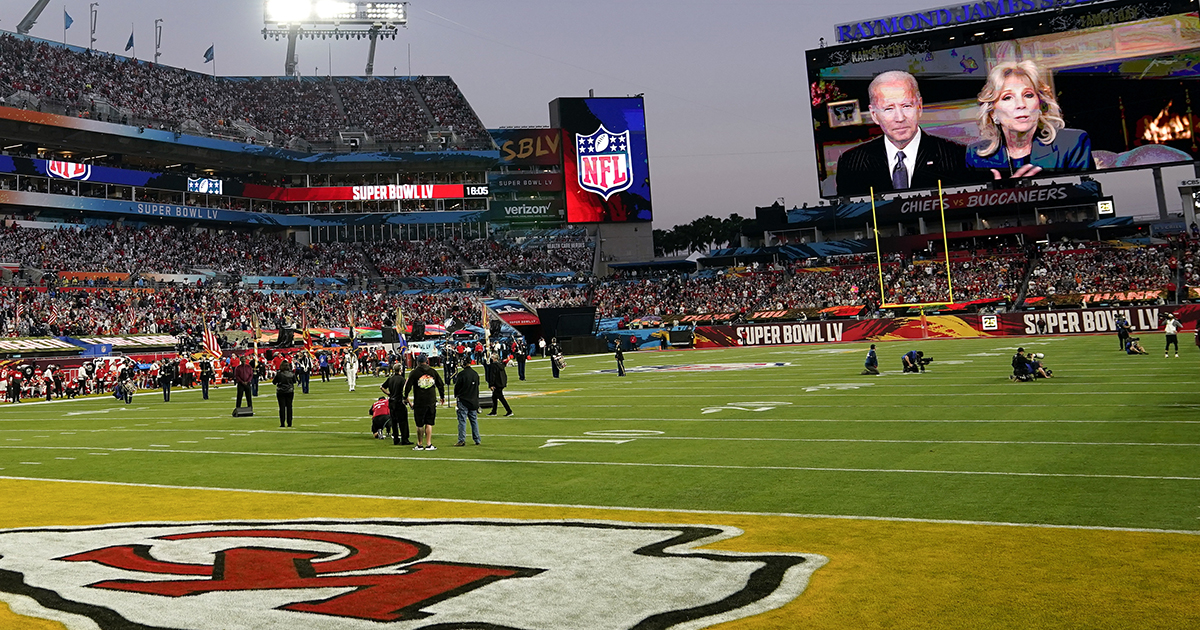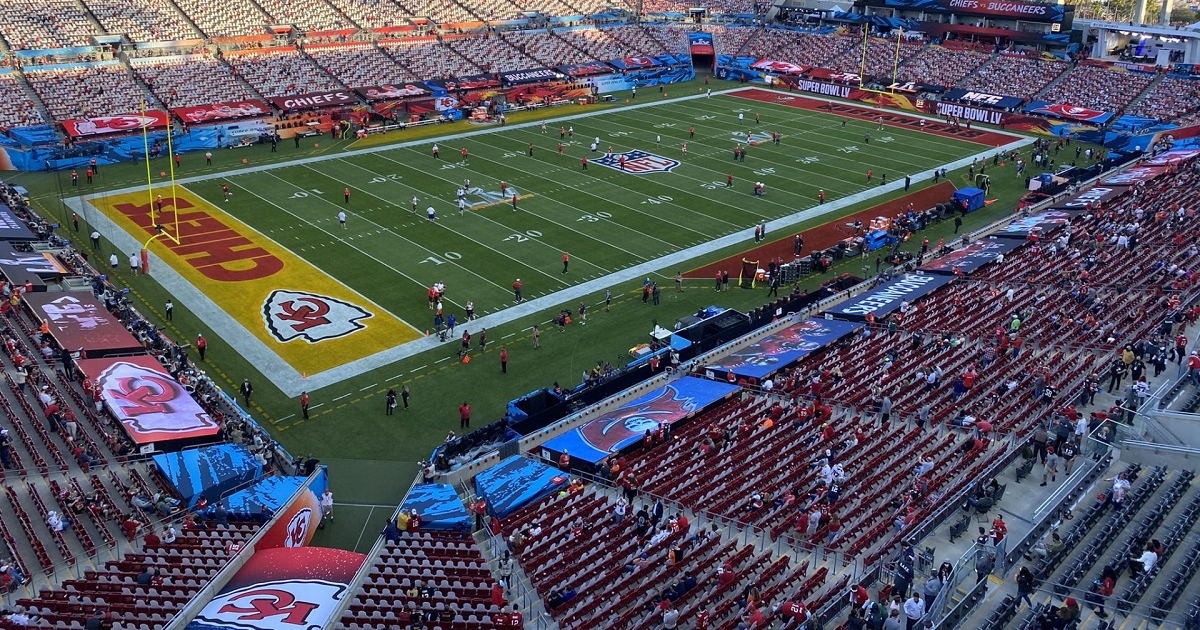It was an NFL season like no other. Except, amazingly, it was a season just like any other.
Deciding to proceed with an entire full-contact sport season in the middle of a pandemic may have seemed improbable at best, foolhardy at worst.
However, Super Bowl LV went ahead right on schedule on Sunday, February 7 following 256 games in the regular season with no cancellations all the way through the playoffs to the big game and victory for quarterback Tom Brady and the Tampa Bay Buccaneers.
The NFL spent more than $75 million on testing alone, playing games on all seven days of the week — shuffling the schedule numerous times — and constantly altering health and safety guidelines to make it through to the Super Bowl in Tampa, Florida.
As Rob Maaddi reported for apnews.com, “There were nervous moments along the way as several teams experienced breakouts. The league had to impose intensive protocol measures to prevent disaster and keep things going.
“Contact tracing devices worn by players, coaches and team personnel played a vital role in the process. Ultimately, the league learned through extensive research and data analysis there was no on-field transmission of the virus during games or practices.”
In the week of Super Bowl LV, the New York Times released a video titled “How the NFL Made it to the Super Bowl During a Pandemic.”
It examined the grand experiment to play a not-at-all socially distanced sport in a pandemic. Producer Robin Stein teamed up with The New York Times NFL reporter Kim Belson to tell the inside story of the 2020-2021 season, specifically looking at the Cleveland Browns and the Seattle Seahawks.
Stein commented, “The playbook required money and resources clearly out of reach for civilians. And still it did not prevent COVID altogether — there were over 700 cases detected throughout the season. But we found that there is a lot the world can glean from what the NFL learned about COVID transmission, testing and controlling outbreaks.”
NFL Super Bowl Gesture for Frontline Healthcare Workers
Super Bowl LV at Tampa’s Raymond James Stadium on February 7 had a reduced capacity of 22,000 fans including 14,500 ticket buyers and 7,500 vaccinated health care workers who were guests of the National Football League. The stadium has a capacity of around 65,000.
The announcement was made by the NFL following discussions with public health officials, including the Centers for Disease Control and Prevention (CDC), the Florida Department of Health, and area hospitals and health care systems.
The majority came from hospitals and health care systems in the Tampa and central Florida area: however, all 32 NFL teams selected vaccinated health care workers from their communities to attend. They received free Super Bowl tickets and game day experiences directly from the NFL.
The NFL also recognized health care workers around the country through a variety of special moments both in the stadium and during the CBS broadcast.
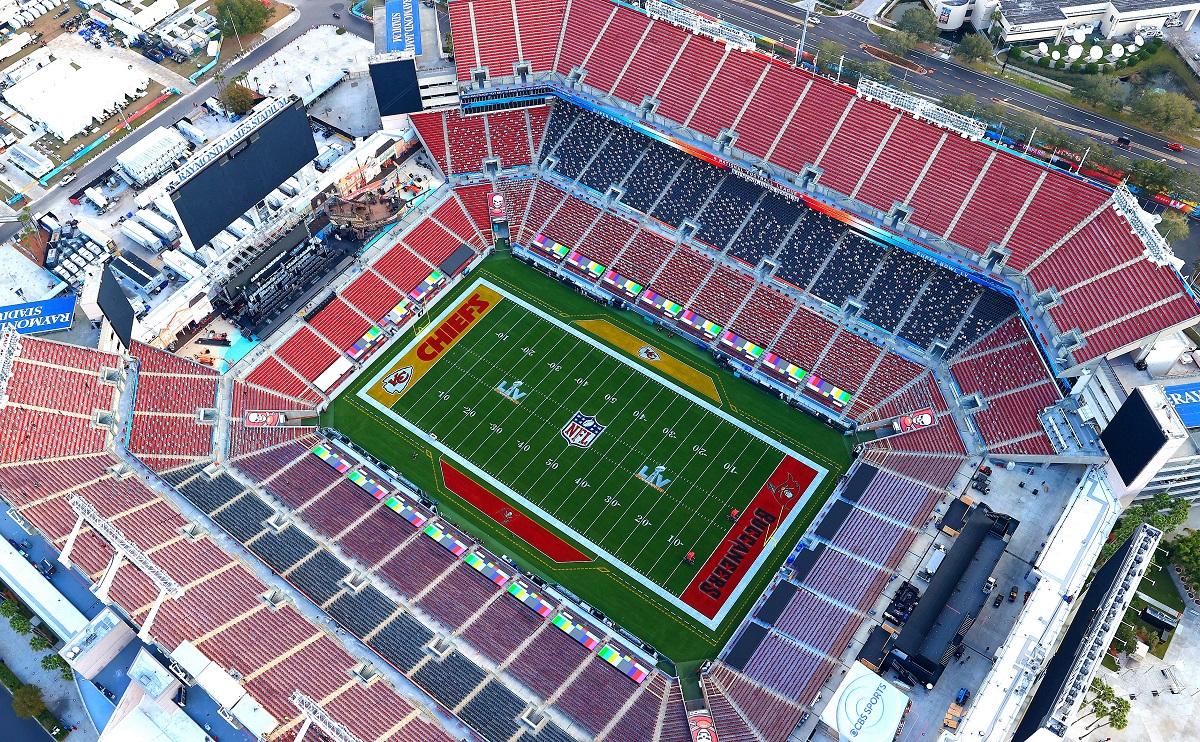
Ed Dixon noted in sportspromedia.com that strict measures were in place “including mandatory face masks and social distancing, as well as podded seating, touchless concessions and controlled entry and exit.”
The venue was also completely cashless on game day, “including parking and in-stadium, to help mitigate health risks. One of the innovations sees ‘reverse ATMs’ introduced, allowing fans to exchange up to US$500 for a pre-paid Visa debit card to use. The same technology was used for Major League Baseball’s (MLB) World Series at Globe Life Field last October.”
Verizon Elevates Super Bowl LV with “Fan-First” Experiences
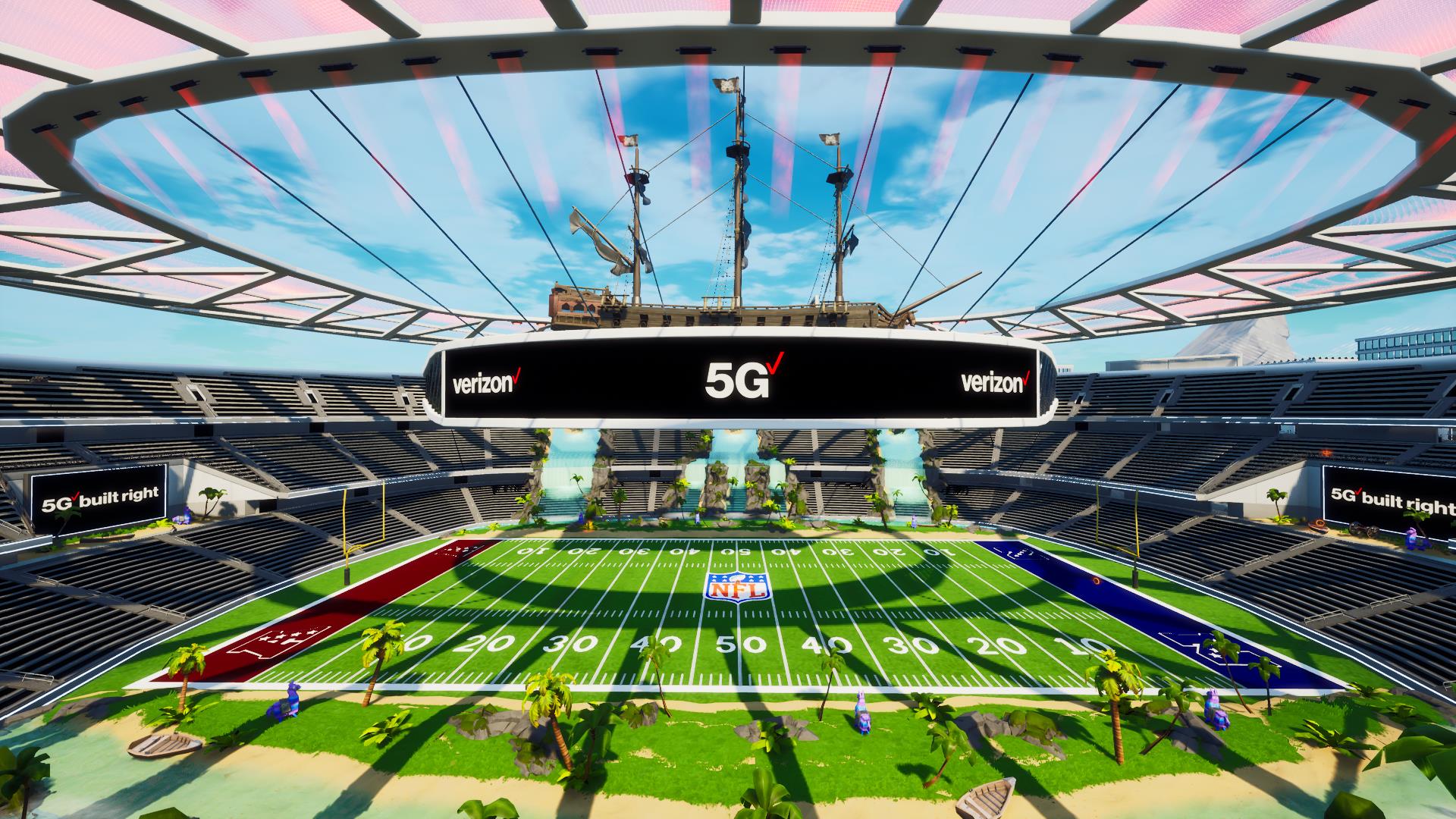
Verizon invested over $80 million to enhance its network to support the Super Bowl. Raymond James Stadium and the surrounding areas received substantial 5G enhancements, including 70 miles of high speed fiber, an upgraded distributed antenna system (DAS), and 281 small cell antennas that provided coverage at events in and around the stadium as well as Downtown Tampa, Ybor City, and the Tampa Riverwalk.
Verizon introduced in-stadium 5G solutions for fans attending in-person in Tampa, delivering immersive and interactive viewing experiences and creating the first-ever 5G Stadium in Epic Games’ Fortnite Creative. Verizon wrapped up Super Bowl weekend by bringing together communities across the country with host Tiffany Haddish and featuring performances by Alicia Keys, Brandi Carlile, Brittany Howard, Christina Aguilera, Eric Church, H.E.R., Jazmine Sullivan, Luke Bryan and Miley Cyrus.
On Super Bowl Sunday the Verizon 5G SuperStadium in the NFL mobile app allowed fans with an iPhone 12 model an opportunity to engage with seven different camera angles while in the stadium and five angles at home, as well as project AR overlays of NFL’s Next Gen Stats for players.
Verizon Media’s Watch Together, a free co-viewing experience in the Yahoo Sports mobile app, gave fans the ability to co-watch Super Bowl LV with friends and family on their phones. Both SuperStadium and Watch Together were powered by Verizon Media Platform’s real-time streaming technology.
“With 5G, we are beginning to see the transformation of various industries and the innovation that comes with it,” said Diego Scotti, CMO, Verizon. “Reimagining live events is one of the best use cases for the power of 5G. During a year like this one, it is a thrill to transform the Super Bowl experience by creating a first-of-its-kind virtual stadium in Fortnite that brings a new level of gaming to life, while at the same time we’re innovating the in-stadium experience.”
CBS Uses Reduced Stadium Capacity to Introduce Cinematic Look
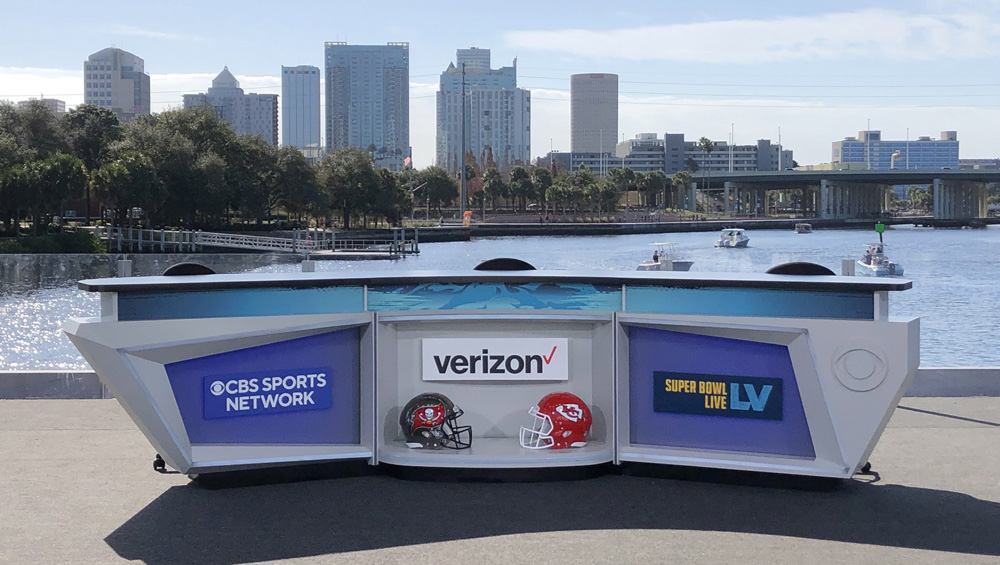
CBS had the Super Bowl broadcast again this year thanks to a 2019 trade with NBC, with the idea of letting NBC have the Super Bowl and the Winter Olympics together next year. CBS Sports Network produced 75 hours of programming throughout Super Bowl week, which included original and studio programming along with daily radio simulcasts leading up to the Sunday kick-off.
On top of the CBS TV broadcast, viewers could watch the game for free on CBSSports.com and the CBS Sports App on phones and connected devices, or through subscription at CBS All Access.
CBS Sports HQ, the 24/7 streaming sports news network available for free across digital platforms, services and connected devices, was live from Tampa during the week leading up to CBS Sports’ live stream of the game. Beginning Monday, February 1, CBS Sports HQ delivered on-site programming and reports throughout each day, and on game day streamed live pre-game coverage, plus post-game analysis and highlights.
In addition to CBS digital properties, the game was streamed free on NFL digital properties across devices, and on mobile via the participating teams’ mobile properties, and Yahoo Sports and other Verizon Media mobile properties. It was also available in Spanish on ESPN Deportes and ESPN digital platforms.
CBS Sports Chairman Sean McManus said on a media call in Super Bowl week that the big game came at the perfect time for the country. “We have great anticipation and excitement for the game and I think it’s coming at a really important time in our country. I think America needs this Super Bowl. It’s an opportunity for the country to come together.
“I think it’s going to be uplifting, I think it’s going to be unifying and I think it’s coming at the right time. I really do hope that it’s a celebration for everything that is great about this country,” said McManus.
CBS Sports used more than 120 cameras and several unusual approaches for Super Bowl LV, largely facilitated by the reduced number of fans in the stadium.
For the first time ever live at the Super Bowl, CBS deployed Trolley Cam, which could speed from one end of the stadium to the other — ziplining along a wire and positioned to provide the viewing angle of a fan in the eighth row of the stands. The rig can travel up to 65 mph and provided a look at the players from a vantage point not seen before at the Super Bowl.
As described by Andrew Bucholtz in awfulannouncing.com, CBS used several on-field cameras to capture a cinematographic feel. Two Sony Venice cameras were used for the first time live at a Super Bowl. The Venice, normally used for cinema-style applications like commercials and movies, used a full frame imager shot in a shallow depth field to give it that “blurred” look. The cameras, provided by Inertia Unlimited, were operated on a Steadicam rig, as well as a MOVI rig to capture the action in what has been likened to a 3D video game look.
In addition a 53-foot Movie Bird crane, usually deployed on motion pictures and television productions, was located on the upper concourse to give sweeping shots of The Super Bowl Today pregame set and game action, as well as serving as one of the many augmented reality encoded cameras that were strategically placed throughout the stadium.
Beyond that, reported Bucholtz, CBS had 12 cameras with 4K and 8K capabilities spread around the stadium for close-ups including “near-field height” achievable due to the reduced number of fans at the game.
To protect the health and safety of its entire crew, CBS Sports continued to utilize alternative production methodologies that were refined and enhanced during the course of this season. While keeping the viewer experience unhindered, extra mobile units in the OB compound allowed for person-to-person social distancing — for a total of 19 working trucks, as opposed to 12 two years ago.
Remote replay operators provided instantaneous footage playbacks from home, and dozens of other editors, graphic operators and show production personnel worked remotely from the CBS Broadcast Center in New York City. Nevertheless, CBS Sports still had a total complement of 800 people on the ground in Tampa.
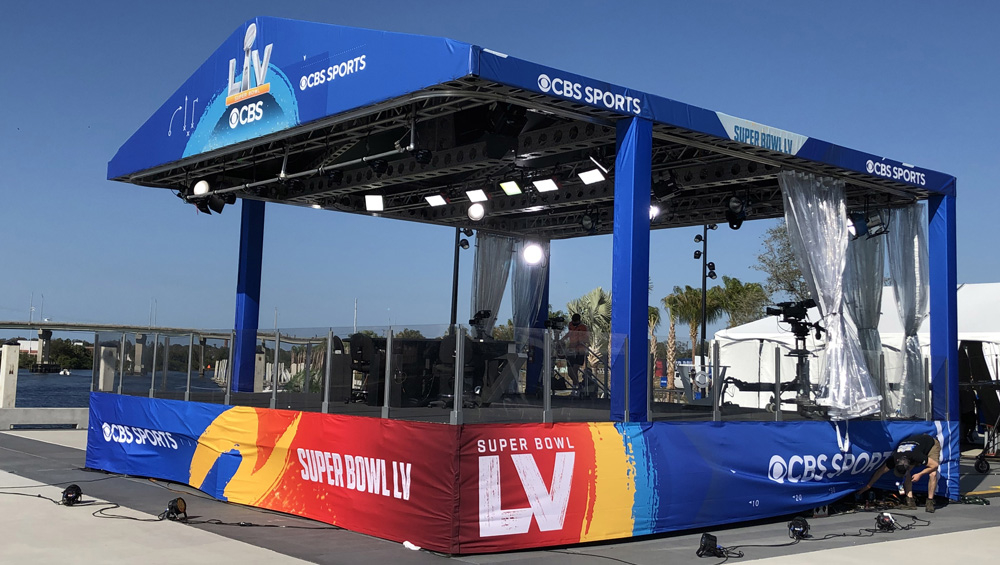
CBS introduced a new look for its graphics at the Super Bowl, according to Michael Groticelli in thebroadcastbridge.com, “using augmented reality systems from a company called Silver Spoon, which has provided virtual production and motion capture services to render the graphics in real time with an on-site Unreal Engine compositing system.”
Silver Spoon also generated the on-field AR graphics with several Skycam systems running across the top of the field. SMP Digital Graphics provided this technology as well as the HD graphics systems for the onscreen score bar.
As usual, NFL Films was on hand to capture cinematic shots from the game, as well as producing a world feed and servicing international rightsholders. In addition to the clean feed of the host broadcast from CBS Sports, reported Jason Dachman at sportsvideo.org, the world feed had five supplemental unilateral cameras.
The world feed was delivered to more than 50 broadcast partners in more than 190 countries and territories around the world. NFL Films Senior Director, International Partner Productions Jeff Lombardi told SVG, “the biggest difference this year would have to be trying to produce our largest event for the world amidst a global pandemic.
“We’ve had to find efficiencies with personnel and facilities onsite in Tampa, while also enlisting additional personnel and facilities as backups in case we’re impacted by positive tests or through contact tracing. The teamwork to get this far through the season has been nothing short of extraordinary.”
The Weeknd’s Star Turn on Super Bowl Weekend
A traditional highlight of the Super Bowl telecast is the halftime show. This year The Weeknd took the spotlight at the Raymond James Stadium.
The performer (real name Abel Tesfaye) stayed true to his promise of delivering a solo act in the stadium, with no celebrities joining him on stage during the performance. However he was accompanied a troupe of dancers, a backing choir and an orchestra of violins.
Jennifer Konerman and Kimberly Nordyke reported in hollywoodreporter.com that The Weeknd put up $7 million of his own money to enhance his performance at the Super Bowl. In other performances on the day, Miley Cyrus took to the stage during a tailgate pregame shown, before the National Anthem was performed by HER, America the Beautiful sung by country artist Eric Church and R&B singer Jazmine Sullivan, and youth poet laureate Amanda Gorman recited a poem.
The Weeknd’s Full Pepsi Super Bowl LV Halftime Show
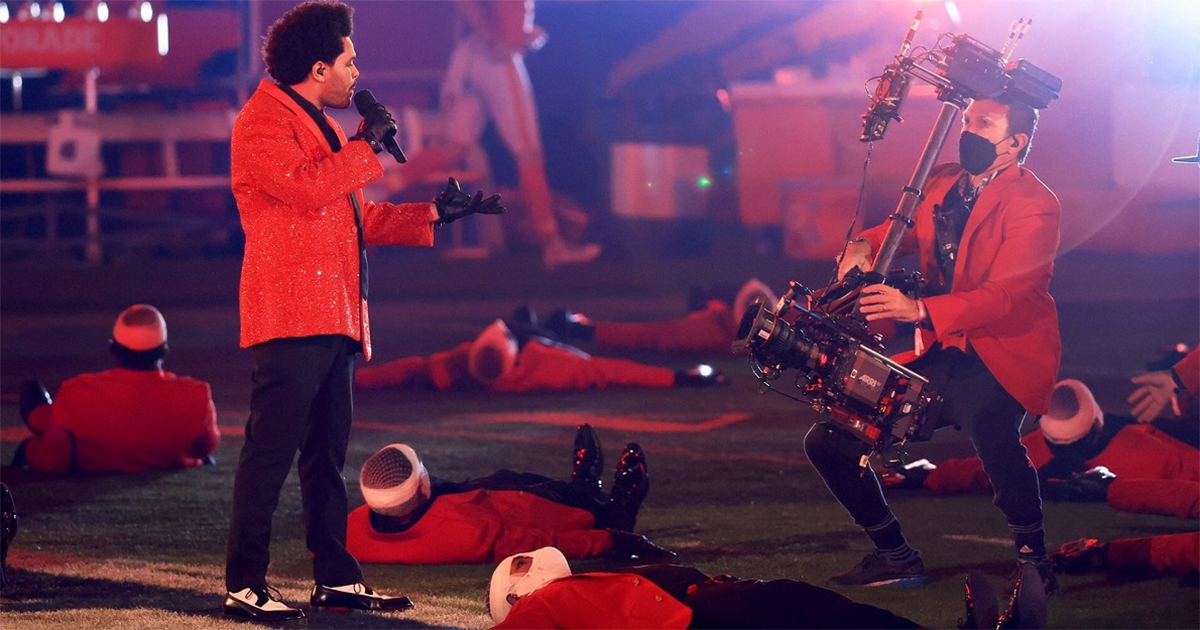
The team at Van Wagner Productions has been at the production helm of the NFL’s showcase weekend for more than three decades, running the in-game production and giving fans in the stadium an entertainment experience to complement the action on the field.
The Super Bowl LV edition was no different, although the global pandemic obviously changed the nature of the production due to reduced capacity. It was also a historical event as the Tampa Bay buccaneers became the first team in the league’s history to play in a championship game at their home stadium.
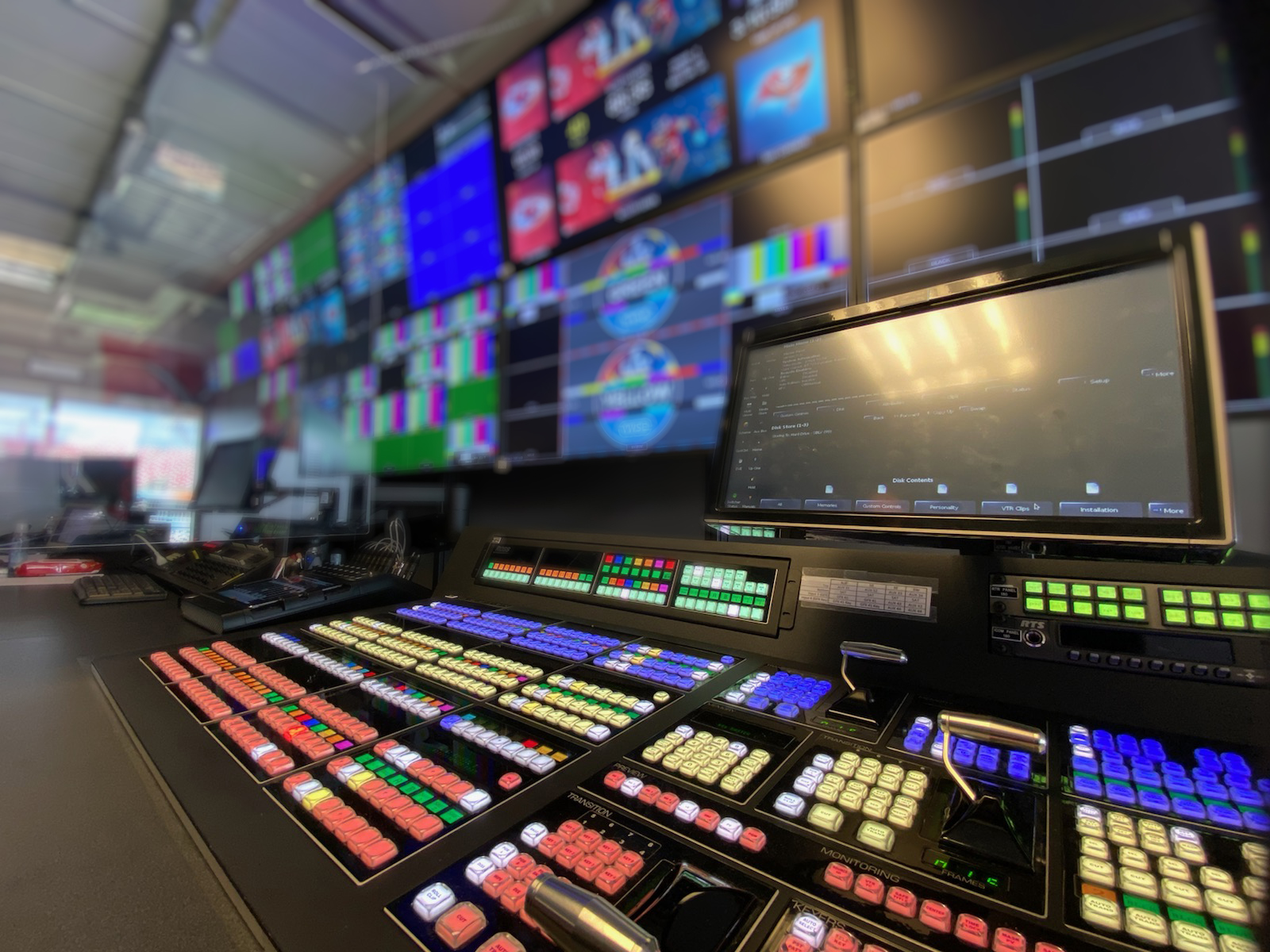
The franchise’s production team, BucsVision, has grown with the Ross Unified Venue Control Solution over the years and, together with Van Wagner and Ross, added more production horsepower for the championship game.
The venue’s control room featured the Acuity production switcher, as well as several XPression Studio engines, which were used for insert graphics. On the LED control side, XPression Tessera drove the main and corner displays, and the DashBoard control system synced all elements of the production together for takeover elements.
Piero Broadcast and Piero Live were added for replay analysis as well as virtual Down & Distance lines. The Ross Voyager graphics rendering solution (powered by the Unreal engine from Epic Games) along with Acid cameras, Furio robotic camera heads, and the Lucid Studio control system helped to deliver AR graphics displaying scoring drives and other Next Gen stats content for fans in attendance.
The stadium also added LED screens to cover the first ten rows of seats. The 360-degree seat cover displays were fed by additional XPression Tessera engines that tied into the existing system.
Super Bowl LV was, as it always is, the most watched television broadcast of the year in the United States. It averaged 96.4 million viewers across all platforms including CBS, ESPN Deportes and streaming across CBS, NFL and Verizon digital and mobile outlets.
This was down about 5.5 per cent from last year’s audience and the smallest total for a Super Bowl since 93.1 million people watched in 2007. The on-air drop for the Super Bowl was in line for rating losses across the NFL’s regular season, when viewing was down about 7 per cent year to year.
However, according to Ben Munson in fiercevideo.com, Super Bowl LV was the most livestreamed NFL game ever with an average minute CBS Sports audience of 5.7 million viewers — representing a 65% increase compared to the Super Bowl in 2020. CBS also said that Super Bowl LV was the first NFL game in history to deliver more than one billion total streaming minutes.


